U.S. Marshals Museum to open virtually in the ‘next five or six weeks’
by October 30, 2017 2:11 pm 779 views

After years of waiting, the United States Marshals Museum (USMM) will “open” in the next five to six weeks — virtually. The building, which still eyes a Sept. 24, 2019 opening day, will be available through virtual reality from the new site location at the intersection of H Street and Riverfront Parkway in Fort Smith.
USMM President and CEO Patrick Weeks hinted at the specifics at a gathering on Thursday night (Oct. 26) from Doe’s Eat Place near the site.
“The reality is that we have a building pad up there that we can actually walk up on to and stand right in the place where things are going to be. And thanks to some work that CDI is going to do for us, there’s going to be some opportunities for experiencing some magic up on that mound somewhere between now and April of next year.”
CDI Contractors, general contractor on the project, will roll out a 3D design/virtual reality simulation that will allow visitors at the site pad to view the location, both interiors and exteriors, as it will be when it opens using a pair of specialized goggles that produce a stereoscopic effect.
Mark Beach, vice-president and COO of the company, gave the short version to attendees, noting anyone would be able to “walk out on the site, stand in a particular place up on the land, put on your goggles, and see what it looks like in real life. We’ll go to work on it (and) hand that back, so you’ll have a way to go out there and see what it might look like.”
By “hand that back,” Beach meant CDI would upload to the cloud, produce the QR code, and deliver it along with VR goggles to Weeks at the current Fort Smith location on 3rd Street. Users will be able to access the viewing app through their phone’s app store. They will download that onto their phones, place the glasses onto the devices, and view at each stake along the site pad.
“We can also come out and take photographs of the existing, or actual, world and blend those together in a video production environment,” Beach said, adding the process allows viewers to “stand at that stake, based on where you are, and look out, then turn around and see what’s behind you as well.”
Weeks added that all one will have to do is “hold it (phone) up to your face and stand inside the museum before the museum is actually built.”
Beach told Talk Business & Politics in a follow-up interview that “today’s designers design buildings in Revit, which is a 3D modeling tool. It’s the newest generation of what used to be AutoCAD. Now it’s 3D, and it’s a data-rich environment. So we take that model, and, with input from the interior designers, add visual textures to it so that it has a sense of real reality and texture of surfaces.”
Counting the time involved, Beach said, cost to supply the “virtual opening” of the museum will be “a few thousand dollars” and “several thousand if you count the investment in the software and infrastructure to support it,” which CDI already owns and uses on other projects. CDI’s virtual reality team will “probably get it done in the next five to six weeks,” Beach said. A rough virtual reality simulation such as the kind Beach highlighted can be viewed at this link.
CDI’s signature projects include the UAMS Winthrop P. Rockefeller Cancer Institute, Arkansas State University Donald W. Reynolds Center for Health Sciences, Robinson Center renovations and additions, Outlets of Little Rock, Walton Arts Center expansion and renovation, Benton Riverside Park, and University of Arkansas Donald W. Reynolds Razorback Stadium north end zone renovation.
The museum has undergone challenges over the last several years trying to get off the ground, namely in fundraising and building costs. The project’s planned $58.6 million budget allowed for a $25 million building, Weeks told Talk Business & Politics, but when 2016 estimates came in, it had “priced itself out” at $33.8 million, “so we had to go back to the drawing board and absorb all costs within that budget, cut some numbers here and cut some numbers there, to make sure that we’re living within our means. So we did that work.”
Weeks said the museum still has $20.5 million more to raise, but the building is now on pace to open by the September 2019 date, and it will keep its iconic star shape and be around 53,000 square feet between the walls.
